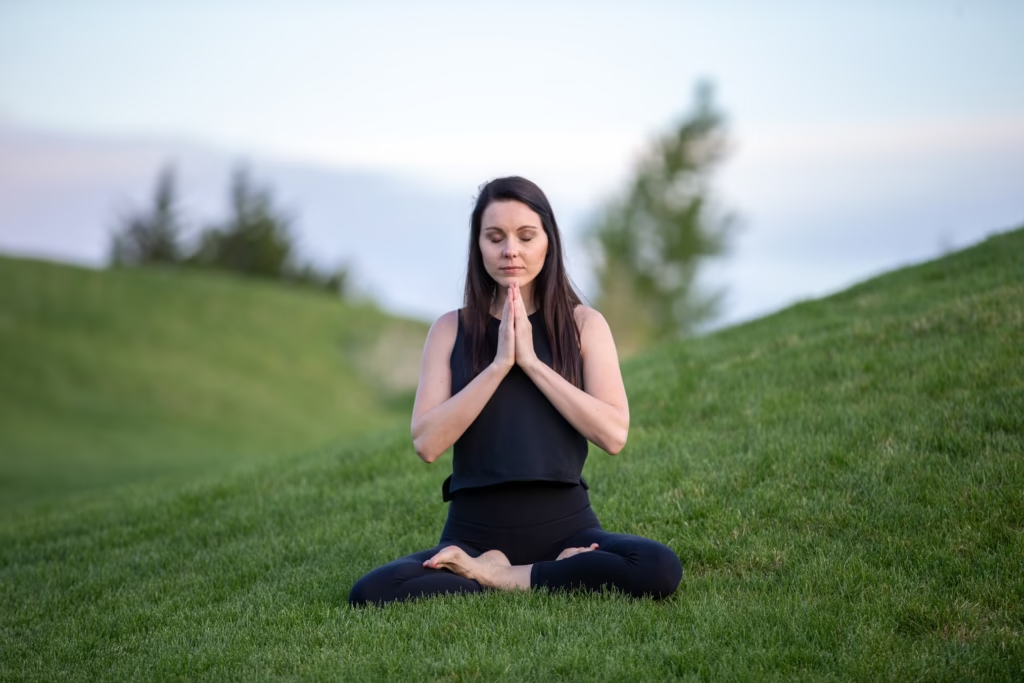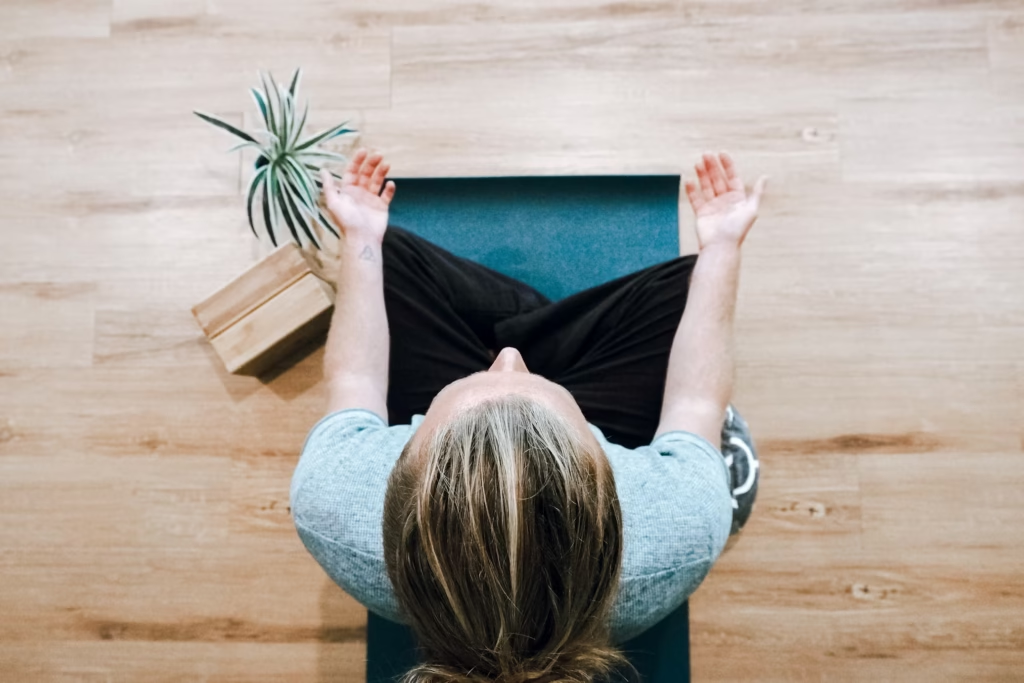How Mindfulness Meditation Can Help Reduce Anxiety and Stress

Stress and anxiety affect millions worldwide, and finding effective ways to manage them is essential for a healthy, fulfilling life. While medications can be helpful for some, lifestyle-based solutions like mindfulness meditation are gaining popularity as sustainable, natural approaches. In this article, we explore how mindfulness meditation reduces stress, provides practical techniques to get started, and highlights the science behind its effectiveness. Let’s dive in!
What is Mindfulness and How Does it Reduce Stress?
Mindfulness is the practice of being fully present in the moment, acknowledging your thoughts, feelings, and surroundings without judgment. It creates a space for awareness and acceptance, which can help calm the mind and reduce stress. Cultures around the world have practiced mindfulness for thousands of years to help cope with stress.
When we’re stressed, our bodies activate the “fight-or-flight” response, flooding us with stress hormones like cortisol. Mindfulness interrupts this cycle, promoting relaxation and emotional regulation.
Key takeaway: Mindfulness shifts your focus from stress-inducing thoughts to the present moment, breaking the stress-response cycle.
Understanding the Mind-Body Connection in Stress Relief
Stress isn’t just a mental phenomenon; it has physical implications too. Chronic stress can lead to insomnia, high blood pressure, digestive issues, and weakened immunity. Mindfulness addresses both mental and physical stress by:
- Reducing Cortisol Levels: Studies show mindfulness practices lower cortisol, the primary stress hormone.
- Improving Heart Rate Variability (HRV): A higher HRV indicates better stress resilience, which mindfulness can enhance.
- Boosting Immunity: By calming the nervous system, mindfulness supports immune function.
The Benefits of Mindfulness for Stress Reduction
Practicing mindfulness is shown in scientific studies to bring numerous benefits, including:
- Enhanced Focus: Reducing mental clutter helps improve concentration.
- Better Emotional Regulation: Mindfulness helps you respond thoughtfully rather than react impulsively.
- Improved Sleep: By calming the mind, mindfulness reduces insomnia and promotes restful sleep.
- Lower Anxiety Levels: Mindfulness decreases symptoms of generalized anxiety disorder (GAD) and social anxiety.
Key Mindfulness Techniques for Stress Relief
Here are some beginner-friendly techniques to integrate mindfulness into your daily life:
1. Body Scan Meditation
Lie down or sit comfortably. Slowly bring your attention to each part of your body, starting from your toes and moving upward. Notice any sensations without judgment.
2. Mindful Breathing
Focus on your breath. Inhale deeply through your nose, hold for a moment, and exhale slowly. Count your breaths if your mind wanders.
3. Mindful Walking
Take a slow, deliberate walk. Pay attention to how your feet feel against the ground, the rhythm of your steps, and the sights and sounds around you.
4. Mindfulness Journaling
Write down your thoughts and feelings each day. Reflect on moments of gratitude to foster a positive outlook.
What Happens in Your Brain When You Practice Mindfulness?
Mindfulness changes your brain positively. Research using brain imaging techniques reveals:
- Increased Gray Matter: Regular practice thickens areas associated with memory, learning, and emotional regulation.
- Reduced Amygdala Activity: The amygdala, responsible for the “fight-or-flight” response, becomes less reactive.
- Enhanced Prefrontal Cortex Function: This area, linked to decision-making and focus, becomes more active.
Mindfulness Meditation: The Core Practice for Stress Relief
Mindfulness meditation is the cornerstone of mindfulness practice. Here’s a simple way to start:
- Find a Quiet Space: Sit or lie down comfortably.
- Close Your Eyes: Focus on your breath.
- Acknowledge Thoughts: If your mind wanders, gently bring your attention back to your breath without judgment.
Start with 5 minutes and gradually increase the duration as you become more comfortable.
How to Start a Mindfulness Practice for Stress Relief
Starting small is key to building a sustainable mindfulness habit. Follow these steps:
- Set a Schedule: Choose a consistent time daily, like mornings or evenings.
- Start Short: Begin with just 2-5 minutes to avoid feeling overwhelmed.
- Use Guided Meditations: Apps like Lx app offer beginner-friendly guided sessions to help you stay on track.
- Create a Calm Environment: Dedicate a quiet, clutter-free space for your practice.
Mindfulness vs. Medication: Which is More Effective for Stress?
While medications can provide immediate relief, mindfulness addresses the root causes of stress. A 2022 study found mindfulness-based stress reduction (MBSR) to be as effective as anti-anxiety medications for some individuals. The choice ultimately depends on your needs and preferences.
Pro tip: Combining mindfulness with other lifestyle changes, like exercise and nutrition, amplifies the benefits.
Real-Life Examples: How Mindfulness Transforms Stress Management
Case Study 1: Sarah, a Busy Attorney
Sarah, a high-powered attorney at a prestigious law firm, was constantly juggling demanding clients, tight deadlines, and the pressure to succeed. The constant stress was taking a toll on her. She experienced frequent headaches, difficulty sleeping, and a general sense of irritability.
To combat this, Sarah began incorporating daily mindfulness meditation into her routine. She started with just 5 minutes each morning, gradually increasing the duration as she felt more comfortable. During these sessions, she focused on her breath, gently guiding her attention back to the present moment whenever her mind wandered.
Within a few weeks, Sarah noticed a significant shift. She found herself better able to handle the pressures of her job. Instead of reacting impulsively to stressful situations, she was able to pause, take a deep breath, and respond more thoughtfully. Her sleep quality improved dramatically, allowing her to wake up refreshed and energized.
This positive impact extended to her work performance. Sarah became more focused and efficient, able to tackle complex legal issues with greater clarity and ease. Her improved communication skills and emotional regulation also fostered stronger relationships with clients and colleagues.
Case Study 2: Mark, a College Student
Mark, a highly driven college student, was plagued by severe test anxiety. The fear of failure would often paralyze him during exams, leading to mental blocks and poor performance.
To overcome this, Mark learned a simple mindful breathing technique. Before each exam, he would find a quiet space and focus on his breath, inhaling deeply and slowly, then exhaling completely. He visualized each breath as a wave of calm washing over him, easing his tension and anxiety.
With consistent practice, Mark noticed a remarkable improvement. His test anxiety gradually diminished, replaced by a sense of calm focus. He found himself able to recall information more easily and think more clearly during exams.
This newfound mental clarity not only improved his academic performance but also boosted his overall confidence. Mark felt more empowered in his studies and less afraid of challenges. He discovered that mindful breathing was a valuable tool not only for exams but also for managing stress in other areas of his life.
These case studies illustrate how mindfulness practices can effectively address real-world stress challenges. By cultivating present moment awareness and developing greater self-awareness, individuals can enhance their emotional resilience, improve their overall well-being, and achieve greater success in their personal and professional lives.
Overcoming Common Challenges in Mindfulness Practice
Why is meditation so hard to focus on my breathing?
It’s normal for beginners to struggle. Remember, mindfulness is about noticing distractions without judgment. Consistency helps improve focus over time.
What to do during meditation when your mind wanders?
Gently redirect your attention to your breath. Treat it as part of the process, not a failure.
Advanced Mindfulness Techniques for Deep Stress Relief
If you’re ready to take your practice to the next level, try:
- Loving-Kindness Meditation: Focus on sending goodwill to yourself and others.
- Mindful Yoga: Combine movement with mindfulness to deepen relaxation.
- Silent Retreats: Dedicate a day or weekend to intensive mindfulness practice.
Mindfulness-Based Stress Reduction (MBSR): What You Need to Know
MBSR is an evidence-based program developed by Dr. Jon Kabat-Zinn. It combines mindfulness meditation with body awareness exercises over 8 weeks. Research shows it’s effective for reducing anxiety, chronic pain, and even symptoms of depression.
- Focus on the Present Moment: MBSR emphasizes cultivating present moment awareness. This involves paying attention to the current experience without judgment, such as sensations in the body, thoughts, and emotions. Techniques like mindful breathing and body scans are used to develop this awareness.
- Acceptance and Non-Judgment: A core principle of MBSR is to accept experiences as they are, without trying to change or resist them. This includes acknowledging thoughts and feelings without judgment or criticism.
- Mindful Movement: MBSR incorporates gentle movement practices like yoga and mindful walking. These activities help to bring awareness to the body and cultivate a sense of ease and relaxation.
- Group Setting: MBSR is typically offered in a group setting, providing a supportive community for participants. Sharing experiences and learning from others can enhance the overall experience and promote a sense of connection.
- Application in Daily Life: MBSR aims to integrate mindfulness practices into daily life. Participants learn to apply mindfulness to everyday activities such as eating, working, and interacting with others, leading to increased awareness and a greater sense of well-being in all aspects of life.
How to Maintain Your Mindfulness Practice for Long-Term Stress Reduction
- Join a Community: Practicing with others can boost motivation.
2. Track Progress: Use tools like the Lx app to monitor your mindfulness journey.
3. Keep Learning: Read books or attend workshops to deepen your understanding.
Conclusion
Mindfulness meditation is a powerful, science-backed tool for reducing stress and improving overall well-being. By focusing on the present moment and adopting simple mindfulness techniques, you can cultivate a calmer, more resilient mind and body. Start small, stay consistent, and watch the transformation unfold.
If you’re ready to explore a holistic approach to reversing chronic stress and improving your health, download the Lx app today and take the first step toward a healthier, drug-free lifestyle.
Frequently Asked Questions About Mindfulness and Stress Relief
How does mindfulness reduce stress?
Mindfulness reduces stress by encouraging individuals to focus on the present moment rather than ruminating on past events or worrying about the future. It also interrupts the “fight-or-flight” response, calming the nervous system and lowering stress hormones like cortisol.
What is an example of mindfulness-based stress reduction?
A common example of mindfulness-based stress reduction (MBSR) is the body scan meditation. This involves lying down and systematically bringing attention to each part of your body, noticing sensations without judgment. This practice helps cultivate awareness and relaxation.
What are three stress relief techniques used in mindfulness practices?
- Mindful Breathing: Focusing on the breath to anchor yourself in the present.
- Mindful Walking: Engaging in slow, intentional walking with awareness of each step.
- Loving-Kindness Meditation: Cultivating compassion for yourself and others.
How do I start mindfulness-based stress reduction?
Start by practicing short guided meditations, like those offered in the Lx app. Choose a quiet environment, set aside a few minutes each day, and focus on your breath or body sensations. Gradually increase your practice time as you become more comfortable.
Why is meditation so hard to focus on my breathing?
Difficulty focusing on your breathing is common, especially for beginners. The mind naturally wanders, but mindfulness teaches you to notice these distractions without judgment and gently return your focus to your breath. Over time, this process becomes easier with practice.
Can meditation heal the body?
Yes it can. It does so by supporting the body’s natural healing processes. By reducing stress, improving sleep, and enhancing immune function, meditation can contribute to better physical health and resilience. Do not underestimate the power of meditation in your healing journey.
What do you think of when meditating?
During meditation, focus on the present moment. This could mean paying attention to your breath, bodily sensations, or even repeating a calming phrase (mantra). Avoid overthinking or judging your thoughts.
What are mindfulness interventions for stress?
Mindfulness interventions include structured programs like MBSR, as well as individual practices such as mindful eating, mindful yoga, and gratitude journaling. These interventions aim to build awareness and reduce stress-related symptoms.
What happens in your brain when you meditate?
Meditation strengthens neural pathways in the brain, particularly in areas related to emotional regulation, memory, and focus. It reduces activity in the amygdala, decreasing stress reactivity, and increases gray matter density in the prefrontal cortex, enhancing cognitive control.
How can I maintain a long-term mindfulness practice?
To sustain your mindfulness journey, integrate it into your daily routine. Use tools like the Lx app to track your progress, join a community for accountability, and continually explore new techniques to keep your practice engaging.


